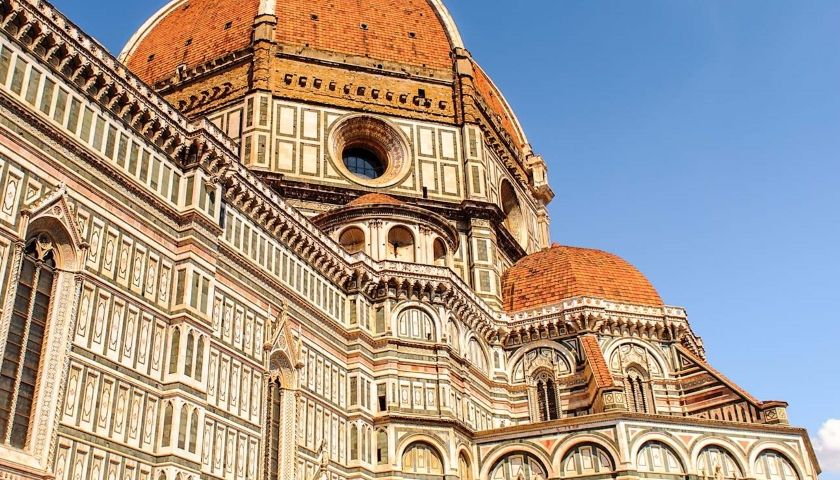As the cradle of the Italian Renaissance, Florence is a never-ending cultural feast. One of the fascinating things about the city of Leonardo, Michelangelo, and Brunelleschi is the way the sacred and the secular coexist: For every art-packed church like Santa Croce or Santa Maria Novella, there's a proud monument to the city's ruling Medici dynasty (Palazzo Vecchio, the Uffizi Gallery) and its wealthy merchant and banking class (Orsanmichele, Palazzo Pitti).
If museums aren't your thing, spend your days discovering some of the many villas and gardens while meandering the winding streets. Or, you know, just eating and shopping your way through the city, too. With so much to do, see, and eat, it's hard to know how best to plan out your itinerary for optimal sightseeing—whether it's your first time visiting or your fifth. This list of the best things to do in Florence is a great place to start.
But remember—no list of things to do can compare to a custom-built itinerary from Nancy Aiello Tours. Leave it to the Italy experts to build a daily travel plan from scratch just for you—with all the must-see sights and hidden gems, but also activities, transportation, and accommodation.
The Best Things To Do In Florence: From Museums to Markets, Piazzas to Neighborhoods
1. Explore Ponte Vecchio
Dating back to 1345, the Ponte Vecchio (aka palazzo vecchio) was the only Florentine bridge that survived destruction by the German forces. After several floods and consequent reconstructions, many jewelers set up shop. The original storefronts still remain at the twinkling Ponte Vecchio today, their trade passed down from generation to generation. Early in the morning, you can observe the shop-owners as they raise the blinds with a special hoist construction. In the afternoon, the bridge gets crowded and it’s difficult to catch a glimpse of its intricacies.
Visit The Cappella Brancacci
The Brancacci Chapel, inside the Oltrarno Church of Santa Maria del Carmine, is where the Renaissance started. Commissioned by a local silk merchant, the fresco cycle that adorns the walls of the chapel is one of the most important in Florentine art. It was the work of three great Renaissance painters: Masolino da Panicale, his pupil Masaccio, and Fra Filippo Lippi. One of the most memorable works is Masaccio's Expulsion of Adam and Eve. The frescoes were celebrated from the outset for their use of the new rules of perspective and their chiaroscuro (light and shade) effects, and artists such as Michelangelo came to study them. Note that admission is strictly limited to 30 people per 15-minute slot and booking is compulsory. This means that, except at very quiet times of year, it is worth booking ahead.
2. Visit The Duomo (Florence Cathedral)
The Basilica di Santa Maria del Fiore, commonly called the Duomo Cathedral of Florence, took two centuries to be finished—but it was worth the effort. The Duomo is stunning from head to toe; the lovingly crafted mosaic floor tiles look almost like a carpet while the dome above you is painted in a fresco inspired by local writer Dante. Don’t miss the 24-hour clock that was designed in 1443—it’s surprisingly modern. Florence’s Duomo the fourth largest cathedral in the world, after St. Peter’s in Rome, St. Paul’s in London, and the Duomo in Milan.
Protip: Keep in mind that, as a religious site, visitors must be wearing appropriate clothing (e.g., no short shorts, tank tops, sandals, hats, or sunglasses).
3. Eat Your Way Through Mercato Centrale
The 19th-century built Mercato Centrale is a gastronomic nirvana, a 95m-long neoclassical food market that is both culinarily and architecturally impressive. The market is essentially an enormous maze of food stalls, which are bursting with local produce, astonishingly fresh fish and seafood, artisan bread, cured meat, and extra creamy Buffalo mozzarella. All the shops are run by artisanal traders who are passionate about their craft, so feel to chat them up as you ogle, taste, and purchase. On the ground floor, you'll find the butchers, fishmongers, fruit and vegetable vendors, and small specialty shops selling local olive oils, meats, cheeses and much, much more. Recently re-opened to the public and renewed in 2014 is the second level to the market, a food hall open seven days a week.
Protip: Parini's is a great stop for Tuscan salumi, cheeses, and dried goods to bring home. They will vacuum seal on request!
4. Visit Galleria dell'Accademia di Firenze
The vast majority of the people in the mile-long line outside this former art school are here for one reason only: to ogle what is probably the most famous nude sculpture in the world, Michelangelo's monumental David. Although you’ll have to endure a line to see the David in all his glory, the famous statue is absolutely worth the wait. The subtle details are impressive and outstanding, from the veins in his arms to the leg muscles and knowing expression on his face. Michelangelo is also the master behind the unfinished San Matteo and four Prigioni, which are also displayed in the gallery.
5. Go Shopping at San Lorenzo Market
The San Lorenzo Markets are actually made up of two separate markets. One is known as the Central Market (Mercato Centrale), which is a two-level indoor food market (you’ll find butchers, fishmongers, produce, and specialty shops with quality pantry items). The other is an outdoor market filled with stalls selling leather, clothes, and kitschy souvenirs.
6. Tour The Uffizi Gallery
The greatest collection of Renaissance painting in the world is housed in the former administrative offices of Cosimo de' Medici's court, a 16th-century building designed by Vasari. Much of the Uffizi's collection originally belonged to the Medici family, known as much for their patronage of the arts as for their role in the city government of Florence. The Uffizi houses the largest collection of Italy's artistic heritage consisting of thousands of works of art ranging from Greek and Roman sculptures to Renaissance and Baroque paintings. Its treasures include Botticelli's Birth of Venus and Titian's Venus of Urbino.
Protip: The gallery contains enough great art to keep you busy for a whole day, but it may take half a day to get in at peak times—unless you book ahead.
7. Explore The Giardino di Boboli of the Pitti Palace
The only park in the center of Florence, the Boboli Gardens (behind Palazzo Pitti) provides a green oasis in the midst of the city's dense Renaissance architecture. Laid out by Buontalenti in the 16th century, it is a wonderful space where you'll come across fountains, statues, secret pathways, lawns, formal gardens, and a thriving population of stray cats. Look for the Neptune Fountain, the beautiful Giardino del Cavaliere at the top of the gardens, Buontalenti's fantastical, newly restored grotto, and the statue of Cosimo I's chubby dwarf astride a turtle, just before the main exit. Be sure to bring water and wear comfortable shoes.
8. Visit Piazzale Michelangelo
Piazzale Michelangelo is one of Florence's most iconic squares, popular due to its sweeping, panoramic views over Florence. Located in the Oltrarno district of the city, it was created fairly recently (by Florence standards, at least) in 1869 by the architect Giuseppe Poggi. As its name suggests, the square was built to pay homage to Michelangelo, with the hillside building intended to house his works. Today, however, it is home to a well-known restaurant, La Loggia, and a coffee bar—along with a bronze replica of the David.
9. Explore Piazza della Signoria
Piazza della Signoria is a storied cultural hub; a meeting place with historic cafes that have been attracting locals for leisurely, early evening apertivi since the 13th century. In the past, townsfolk congregated at the piazza whenever the city was amidst political crises. Upon visiting, pay particular attention to the equestrian statue of Cosimo I by Giambologna in the center of the piazza, as opposed to the copies of Michelangelo and David sculptures.
10. Visit Medici Chapel (Cappelle Medicee)
Attached to the church of San Lorenzo, this complex of three rooms is the final resting place of Medicis great and small. Minor family members were relegated to the crypt, while Cosimo I turned the Cappella dei Principi, with its lashings of marble, into a bombastic exercise in self-glorification. But Michelangelo's Sagrestia Nuova is the real draw. Fresh from painting the Sistine ceiling in Rome, the returning prodigal son produced some of his most original sculptural works in the two finished Medici tombs that dominate the space. The tomb of Giuliano, youngest son of Lorenzo de' Medici, is crowned by twin reclining statues of Night and Day, while that of Lorenzo's eponymous grandson, Lorenzo Duke of Urbino, is capped by figures of Dawn and Dusk.
11. Visit The Pitti Palace
The Palazzo Pitti is a vast Renaissance palace situated on the south side of the Arno River. Designed in 1457, the original residence of the Medici Family now houses the Palatine Gallery, the Silver Museum, the Museum of Modern Art, the Costume Gallery, the Porcelain Museum, and the Museum of Carriages. Expect to see intricate amber carvings, glittering tiaras, elaborately frescoed audience chambers, and a collection of 16th-19th century art.
12. Explore The Oltrarno
Long overlooked and used as a means to reach other destinations, Florence’s Oltrarno neighborhood has recently been transformed into a veritable cultural hub. There’s plenty to do in the reimagined area: enjoy the view from the centuries-old walkway above the ancient Porta Romana, post-up at the ancient buildings that have been repurposed as bars and restaurants, visit the studio of jeweler and artist Marina Calamai, and gawk at the beautiful clothes at Quelle Tre boutique.
13. Visit The Riccardi Medici Palace
Palazzo Medici Riccardi is one of the most important architectural sites in Florence, and the storied home to many of the city's most famous residents. Commissioned to Michelozzo in 1444 by Cosimo the Eldest, the palace was the project of many other artists, including Michelangelo. Eventually, the Medici family sold the palace to the Riccardi, who extended the palace, adding Baroque stylings. One of the magnificent features of the palace is the Chapel of the Magi, adorned with famous and breathtaking frescoes by Benozzo Gozzoli. Visit the incredible museum to get a sense of the power and wealth these influential families had in the worlds of art and culture.
14. Visit The Basilica of Santa Croce
The Basilica of Santa Croce is Florence's most iconic Franciscan church and burial site for some of the city's most notable historical figures, including Galileo, Michelangelo, and Vittorio Alfieri. It's decorated with some of the city's most stunning frescoes, including those by Giotto in the Bardi and Peruzzi chapels, and is located on the Piazza di Santa Croce, just southeast of the Duomo.
15. Explore The Piazza della Repubblica
Piazza della Repubblica has been a hallmark of the city center since the Roman era. Today, the 19th-century square is characterized by the Colonna dell'Abbondanza (Column of Abundance), the triumphal arch known as Arcone, and lively cafes that were popular with writers and artists at the turn of the 20th century.
16. Visit Santa Maria Novella
No matter where you are in Florence, you’ll likely be able to see the green and white marble exterior of the 13th-century basilica, Santa Maria Novella. The basilica is formed by a cluster of monastic buildings, such as church cloisters and a frescoed chapel. Housing some spectacular Gothic and early-Renaissance artistic works, including frescoes by Domenico Ghirlandaio, the basilica is worth a visit for first-time and repeat visitors alike.
Explore The Archeological Museum (Museo Archeologico)
The Archaeological Museum is one of Florence's hidden gems, housing a large and impressive collection of Egyptian and Etruscan, as well as Greek and Roman artifacts and art. The collection originally began with the Medici who were fascinated by Italy's early inhabitants, the Etruscans. As archaeology reached its heyday in the 1800's, the collection was added to by Italy's wealthiest families. Most notable among the collection is the Roman statue, Idolino, and the Francois Vase, considered by many to be the equivalent of a genealogy of Greek mythology. Also, visit the museum's collection of Egyptian mummies and the reconstruction of a 2nd century Etruscan tomb.
Helpful Hints
- This museum is located 1 block away from the Galleria dell'Accademia and the Monastery of San Marco.
- You are allowed to stay in the museum as long as you would like after entrance. You should plan for at least 1 hour to view the full collection.
- The Archaeology Museum is closed every Monday, as well as December 25, January 1 and May 1.
- The Archaeology Museum i is located near the Galleria dell'Accademia and Museo San Marco and is only a 10 minute walk from the Duomo, 15 minute walk from the Galleria degli Uffizi.
17. Head to The Top of Giotto's Bell Tower
One of the four principal monuments of the Piazza del Duomo, Giotto’s Bell Tower is a striking, 87.5m tall tower, built in red, white, and green marble. Begun in 1334 by Giotto (he died before its completion), the tower is an iconic example of 14th-century Gothic architecture. Hexagonal panels, lozenges, and reliefs tell the story of the creation of man, and his spiritual and intellectual pursuits. The tower was eventually finished in 1359 by Talenti, who is responsible for the two large windows at the top of the tower, as well as the terrace, which can be reached if you climb the 400 steps to the top.
18. Visit The Leonardo da Vinci Museum
Located in the center of Florence, the da Vinci Museum is home to invention models, designs, and art by the Renaissance genius. The space is divided into five interactive sections that give you unique insights into one of the most beautiful minds in history. Wander through the installations on mechanisms (featuring Leonardo’s designs for worm screws, ball bearers, and more), earth (Leonardo’s printing press, odometer, and rolling mill), water (including a hydraulic saw still in use today), air (featuring Leonardo’s parachute and wings), and fire (where you can see da Vinci’s armored tank).
Protip: Don’t miss the fantastic bookshop, where you’ll find fascinating, one-of-a-kind Leonardo souvenirs.
Explore Fiesole
A small hill town just to the north of Florence, Fiesole was founded by the Etruscans. Today, it is a charming upmarket suburb accessible by a short taxi ride from the city. Life centers around Piazza Mino, a lively old square lined with cafés and restaurants. There are some interesting sights, including the fine 11th-century Duomo and the Museo Bandini, with its Gothic paintings and Della Robbia terra-cottas. Relics of Etruscan and Roman Faesulae can be seen in the Teatro Romano and the Museo Archeologico, and there are wonderful views of Florence from the monastery of San Francesco up the hill.
19. Visit Gucci Garden
Guccio Gucci opened his first leather goods and luggage shop in Florence in 1921, targeting the kind of luxury clientele he had seen while working as a bellboy at the Savoy in London. Since then the company he founded has become a huge global brand. On its 90th anniversary in 2011, Gucci opened its first museum in its founder's hometown, to preserve the brand’s history, as well as support the local arts scene. Located on a prime centro storico piece of real estate—14th-century Palazzo della Mercanzia in Piazza della Signoria, the museum encompasses three floors of exhibition space, much of which is dedicated to the history of the development of the brand. You can also visit the Icon Store (with exclusive collection items) and the delicious Gucci Osteria da Massimo Bottura.
20. Pop Into Basilica di Santo Spirito
The Basilica di Santo Spirito is one of the greatest off-the-beaten-path attractions in Florence. While exploring the Oltrarno area, be sure to stop in this beautiful church. Designed by Brunelleschi and housing a wooden crucifix done by Michelangelo (when he was only 17!), it is one of the best examples of Renaissance art and architecture on this side of the river.
21. Visit The Bargello National Museum
Museo Nazionale del Bargello is an essential stop for art and history buffs looking to skip the long Florence museum lines. The old prison has been converted into a light and airy museum over three floors, with outstanding works of sculpture, pieces of Florentine history (particularly the coin collection), and an impressive display of weapons and armor.
22. Visit The San Marco Museum
Located on the Piazza San Marco, the museum of the same name is a great spot to check out before or after visiting the Galleria dell’Accademia, as it is only five minutes away. At this beautiful, quiet museum (formerly a Dominican convent), you’ll find many breathtaking frescoes by famous Renaissance artists like Bernardino Poccetti and Fra Angelico. If you love early Renaissance art, the Museo di San Marco is a goldmine. Plus, it's a nice, calm break from the crowds at the David.
23. Visit The Stibbert Museum
The Stibbert Museum is entirely dedicated to the eclectic tastes of a 19th-century art collector by the name of Frederick Stibbert. Having inherited his fortune, Stibbert eschewed work and instead spent his entire life collecting antiques and artifacts. When he passed away in 1906, his collection was gifted to the city of Florence and opened to the public. Today, the villa museum has 57 rooms (with walls covered in tapestries), as well as a café and bookstore.
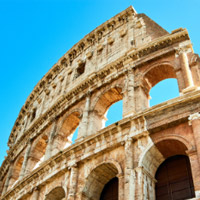 Rome & Vatican
Rome & Vatican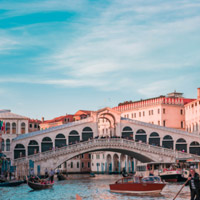 Venice
Venice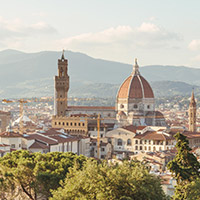 Florence & Tuscany
Florence & Tuscany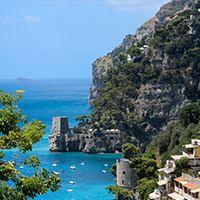 Napoli & Amalfi Coast
Napoli & Amalfi Coast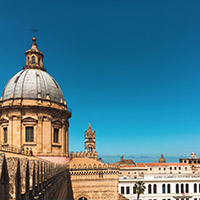 Sicily
Sicily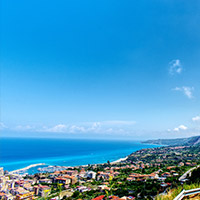 Calabria
Calabria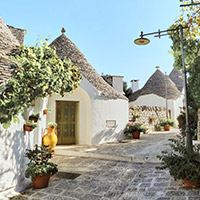 Matera & Puglia
Matera & Puglia